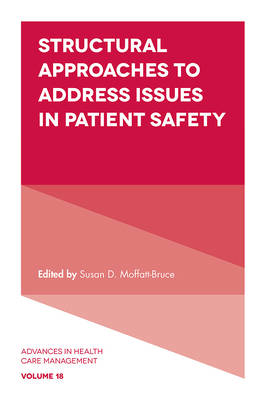
- Afhalen na 1 uur in een winkel met voorraad
- Gratis thuislevering in België vanaf € 30
- Ruim aanbod met 7 miljoen producten
- Afhalen na 1 uur in een winkel met voorraad
- Gratis thuislevering in België vanaf € 30
- Ruim aanbod met 7 miljoen producten
Zoeken
Structural Approaches to Address Issues in Patient Safety
€ 188,45
+ 376 punten
Omschrijving
This volume explores the ways in which structural changes in health care environments impact patient safety. It delves into the potential that design thinking can have when applied to organizational systems and structures, as well as the physical environment, to mitigate risks, reduce medical errors and ultimately improve the quality of care, provider well-being, and the overall patient experience.
Much of health management empirical research has focused on the process and outcomes and then attempted to reverse engineer the structure that may reasonably explain that. This volume presents studies from the United States and Europe to demonstrate the benefits of a structure led approach. The chapters employ a variety of methods including needs assessment, consensus building, systems modelling, survey research, secondary analysis of EMR data, and qualitative methodologies. Together they provide meaningful conclusions to the question of how structural approaches in learning health care environments can be improved to create a positive impact on patient safety.
Much of health management empirical research has focused on the process and outcomes and then attempted to reverse engineer the structure that may reasonably explain that. This volume presents studies from the United States and Europe to demonstrate the benefits of a structure led approach. The chapters employ a variety of methods including needs assessment, consensus building, systems modelling, survey research, secondary analysis of EMR data, and qualitative methodologies. Together they provide meaningful conclusions to the question of how structural approaches in learning health care environments can be improved to create a positive impact on patient safety.
Specificaties
Betrokkenen
- Uitgeverij:
Inhoud
- Aantal bladzijden:
- 296
- Taal:
- Engels
- Reeks:
- Reeksnummer:
- nr. 18
Eigenschappen
- Productcode (EAN):
- 9781838670856
- Verschijningsdatum:
- 24/10/2019
- Uitvoering:
- Hardcover
- Formaat:
- Genaaid
- Afmetingen:
- 155 mm x 231 mm
- Gewicht:
- 557 g

Alleen bij Standaard Boekhandel
+ 376 punten op je klantenkaart van Standaard Boekhandel
Beoordelingen
We publiceren alleen reviews die voldoen aan de voorwaarden voor reviews. Bekijk onze voorwaarden voor reviews.







